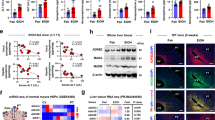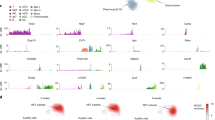Abstract
Neutrophil infiltration is a hallmark of alcoholic steatohepatitis; however, the underlying mechanisms remain unclear. We previously reported that chronic-plus-binge ethanol feeding synergistically induces hepatic recruitment of neutrophils, which contributes to liver injury. In this paper, we investigated the roles of invariant natural killer T (iNKT) cells in chronic-plus-binge ethanol feeding-induced hepatic neutrophil infiltration and liver injury. Wild-type and two strains of iNKT cell-deficient mice (CD1d- and Jα18-deficient mice) were subjected to chronic-plus-binge ethanol feeding. Liver injury and inflammation were examined. Chronic-plus-binge ethanol feeding synergistically increased the number of hepatic iNKT cells and induced their activation, compared with chronic feeding or binge alone. iNKT cell-deficient mice were protected from chronic-plus-binge ethanol-induced hepatic neutrophil infiltration and liver injury. Moreover, chronic-plus-binge ethanol feeding markedly upregulated the hepatic expression of several genes associated with inflammation and neutrophil recruitment in wild-type mice, but induction of these genes was abrogated in iNKT cell-deficient mice. Importantly, several cytokines and chemokines (e.g., MIP-2, MIP-1, IL-4, IL-6 and osteopontin) involved in neutrophil infiltration were upregulated in hepatic NKT cells isolated from chronic-plus-binge ethanol-fed mice compared to pair-fed mice. Finally, treatment with CD1d blocking antibody, which blocks iNKT cell activation, partially prevented chronic-plus-binge ethanol-induced liver injury and inflammation. Chronic-plus-binge ethanol feeding activates hepatic iNKT cells, which play a critical role in the development of early alcoholic liver injury, in part by releasing mediators that recruit neutrophils to the liver, and thus, iNKT cells represent a potential therapeutic target for the treatment of alcoholic liver disease.
This is a preview of subscription content, access via your institution
Access options
Subscribe to this journal
Receive 12 digital issues and online access to articles
$119.00 per year
only $9.92 per issue
Buy this article
- Purchase on Springer Link
- Instant access to full article PDF
Prices may be subject to local taxes which are calculated during checkout








Similar content being viewed by others
References
Gao B, Bataller R . Alcoholic liver disease: pathogenesis and new therapeutic targets. Gastroenterology 2011; 141: 1572–1585.
O'Shea RS, Dasarathy S, McCullough AJ, Practice Guideline Committee of the American Association for the Study of Liver D, the Practice Parameters Committee of the American College of G. Alcoholic liver disease. Hepatology 2010; 51: 307–328.
Lucey MR, Mathurin P, Morgan TR . Alcoholic hepatitis. N Engl J Med 2009; 360: 2758–2769.
Williams JA, Manley S, Ding WX . New advances in molecular mechanisms and emerging therapeutic targets in alcoholic liver diseases. World J Gastroenterol 2014; 20: 12908–12933.
Bellentani S, Saccoccio G, Costa G, Tiribelli C, Manenti F, Sodde M et al. Drinking habits as cofactors of risk for alcohol induced liver damage. Gut 1997; 41: 845–850.
Stranges S, Freudenheim JL, Muti P, Farinaro E, Russell M, Nochajski TH et al. Differential effects of alcohol drinking pattern on liver enzymes in men and women. Alcohol Clin Exp Res 2004; 28: 949–956.
Zakhari S, Li TK . Determinants of alcohol use and abuse: impact of quantity and frequency patterns on liver disease. Hepatology 2007; 46: 2032–2039.
Shukla SD, Pruett SB, Szabo G, Arteel GE . Binge ethanol and liver: new molecular developments. Alcohol Clin Exp Res 2013; 37: 550–557.
Barrio E, Tome S, Rodriguez I, Gude F, Sanchez-Leira J, Perez-Becerra E et al. Liver disease in heavy drinkers with and without alcohol withdrawal syndrome. Alcohol Clin Exp Res 2004; 28: 131–136.
Wang HJ, Gao B, Zakhari S, Nagy LE . Inflammation in alcoholic liver disease. Annu Rev Nutr 2012; 32: 343–368.
Szabo G, Petrasek J, Bala S . Innate immunity and alcoholic liver disease. Dig Dis 2012; 30 Suppl 1: 55–60.
Mandrekar P, Ambade A, Lim A, Szabo G, Catalano D . An essential role for monocyte chemoattractant protein-1 in alcoholic liver injury: regulation of proinflammatory cytokines and hepatic steatosis in mice. Hepatology 2011; 54: 2185–2197.
Wan J, Benkdane M, Teixeira-Clerc F, Bonnafous S, Louvet A, Lafdil F et al. M2 Kupffer cells promote M1 Kupffer cell apoptosis: a protective mechanism against alcoholic and nonalcoholic fatty liver disease. Hepatology 2014; 59: 130–142.
Gao B, Radaeva S, Park O . Liver natural killer and natural killer T cells: immunobiology and emerging roles in liver diseases. J Leukoc Biol 2009; 86: 513–528.
Kumar V . NKT-cell subsets: promoters and protectors in inflammatory liver disease. J Hepatol 2013; 59: 618–620.
Santodomingo-Garzon T, Swain MG . Role of NKT cells in autoimmune liver disease. Autoimmun Rev 2011; 10: 793–800.
Kronenberg M . Toward an understanding of NKT cell biology: progress and paradoxes. Annu Rev Immunol 2005; 23: 877–900.
Bendelac A, Savage PB, Teyton L . The biology of NKT cells. Annu Rev Immunol 2007; 25: 297–336.
Brigl M, Brenner MB . How invariant natural killer T cells respond to infection by recognizing microbial or endogenous lipid antigens. Semin Immunol 2010; 22: 79–86.
Mattner J . Natural killer T (NKT) cells in autoimmune hepatitis. Curr Opin Immunol 2013; 25: 697–703.
Swain MG . Natural killer T cells within the liver: conductors of the hepatic immune orchestra. Dig Dis 2010; 28: 7–13.
Minagawa M, Deng Q, Liu ZX, Tsukamoto H, Dennert G . Activated natural killer T cells induce liver injury by Fas and tumor necrosis factor-α during alcohol consumption. Gastroenterology 2004; 126: 1387–1399.
Bertola A, Park O, Gao B . Chronic plus binge ethanol feeding synergistically induces neutrophil infiltration and liver injury in mice: a critical role for E-selectin. Hepatology 2013; 58: 1814–1823.
Eberl G, Lees R, Smiley ST, Taniguchi M, Grusby MJ, MacDonald HR . Tissue-specific segregation of CD1d-dependent and CD1d-independent NK T cells. J Immunol 1999; 162: 6410–6419.
Martin-Murphy BV, Kominsky DJ, Orlicky DJ, Donohue TM Jr, Ju C . Increased susceptibility of natural killer T-cell-deficient mice to acetaminophen-induced liver injury. Hepatology 2013; 57: 1575–1584.
Ramaiah SK, Jaeschke H . Role of neutrophils in the pathogenesis of acute inflammatory liver injury. Toxicol Pathol 2007; 35: 757–766.
Diao H, Kon S, Iwabuchi K, Kimura C, Morimoto J, Ito D et al. Osteopontin as a mediator of NKT cell function in T cell-mediated liver diseases. Immunity 2004; 21: 539–550.
Matsuda JL, Mallevaey T, Scott-Browne J, Gapin L . CD1d-restricted iNKT cells, the ‘Swiss-Army knife’ of the immune system. Curr Opin Immunol 2008; 20: 358–368.
Schnabl B, Brenner DA . Interactions between the intestinal microbiome and liver diseases. Gastroenterology 2014; 146: 1513–1524.
Hartmann P, Chen P, Wang HJ, Wang L, McCole DF, Brandl K et al. Deficiency of intestinal mucin-2 ameliorates experimental alcoholic liver disease in mice. Hepatology 2013; 58: 108–119.
Rao R . Endotoxemia and gut barrier dysfunction in alcoholic liver disease. Hepatology 2009; 50: 638–644.
Kinjo Y, Wu D, Kim G, Xing GW, Poles MA, Ho DD et al. Recognition of bacterial glycosphingolipids by natural killer T cells. Nature 2005; 434: 520–525.
Buschard K, Hansen AK, Jensen K, Lindenbergh-Kortleve DJ, de Ruiter LF, Krohn TC et al. Alcohol facilitates CD1d loading, subsequent activation of NKT cells, and reduces the incidence of diabetes in NOD mice. PLoS One 2011; 6: e17931.
Kubes P, Mehal WZ . Sterile inflammation in the liver. Gastroenterology 2012; 143: 1158–1172.
Wang H, Feng D, Park O, Yin S, Gao B . Invariant NKT cell activation induces neutrophil accumulation and hepatitis: opposite regulation by IL-4 and IFN-gamma. Hepatology 2013; 58: 1474–1485.
Cheng L, You Q, Yin H, Holt MP, Ju C . Involvement of natural killer T cells in halothane-induced liver injury in mice. Biochem Pharmacol 2010; 80: 255–261.
Morales-Ibanez O, Dominguez M, Ki SH, Marcos M, Chaves JF, Nguyen-Khac E et al. Human and experimental evidence supporting a role for osteopontin in alcoholic hepatitis. Hepatology 2013; 58: 1742–1756.
Lazaro R, Wu R, Lee S, Zhu NL, Chen CL, French SW et al. Osteopontin deficiency does not prevent but promotes alcoholic neutrophilic hepatitis in mice. Hepatology 2015; 69: 129–140.
Ge X, Leung TM, Arriazu E, Lu Y, Urtasun R, Christensen B et al. Osteopontin binding to lipopolysaccharide lowers tumor necrosis factor-alpha and prevents early alcohol-induced liver injury in mice. Hepatology 2014; 59: 1600–1616.
Acknowledgements
This work was supported by the intramural program of NIAAA, NIH (BG), U01AA021723 (to CJ and BG) and R01 AA020864 &R01 CA100660 (VK).
Author information
Authors and Affiliations
Corresponding author
Ethics declarations
Competing interests
There is no conflict of interest to disclose for all authors.
Additional information
Supplementary Information accompanies the paper on Cellular & Molecular Immunology's website. (http://www.nature.com/cmi).
Supplementary information
Rights and permissions
About this article
Cite this article
Mathews, S., Feng, D., Maricic, I. et al. Invariant natural killer T cells contribute to chronic-plus-binge ethanol-mediated liver injury by promoting hepatic neutrophil infiltration. Cell Mol Immunol 13, 206–216 (2016). https://doi.org/10.1038/cmi.2015.06
Received:
Accepted:
Published:
Issue Date:
DOI: https://doi.org/10.1038/cmi.2015.06
Keywords
This article is cited by
-
Sex-based differences in natural killer T cell-mediated protection against diet-induced steatohepatitis in Balb/c mice
Biology of Sex Differences (2023)
-
Mesenchymal stem cells-based therapy in liver diseases
Molecular Biomedicine (2022)
-
M2-specific reduction of CD1d switches NKT cell-mediated immune responses and triggers metaflammation in adipose tissue
Cellular & Molecular Immunology (2018)
-
Astaxanthin alleviated ethanol-induced liver injury by inhibition of oxidative stress and inflammatory responses via blocking of STAT3 activity
Scientific Reports (2018)
-
NKT cells in liver diseases
Frontiers of Medicine (2018)



